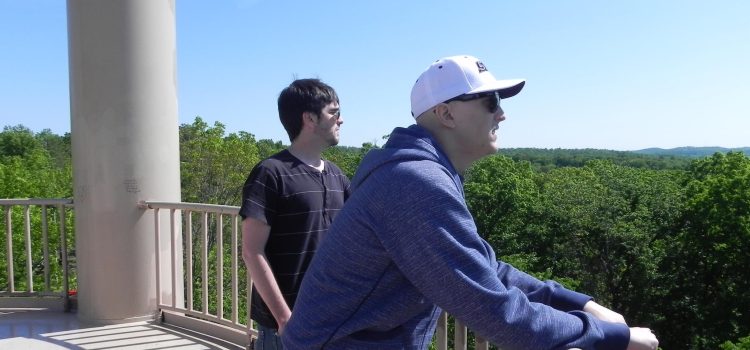The St. Louis High School Musical Theatre Awards winners were announced Thursday, May 15 at The Fabulous Fox. The ceremony was hosted by 2019 & 2020 SLHSMTA Outstanding Lead Actor winner Michael Harp and directed by Lee Anne Mathews. The winners were named in 19 categories (plus WOW! Performance Awards and Special Recognition Awards) including the Outstanding Lead Actress
and the Outstanding Lead Actor who will go on to compete in the Jimmy Awards/National High School Musical Theatre Awards on Monday, June 23 at the Minskoff Theatre in New York City, presented by The Broadway League Foundation.
Outstanding Musical Level 1:
Westminster Christian Academy, Hello, Dolly!
Outstanding Musical Level 2:
Lutheran High School South, Little Women

Outstanding Lead Actor, Tyler Bugg for his performance as Orpheus in Liberty High School’s production of Hadestown: Teen Edition
Outstanding Lead Actress:
Amelie Lock | Ladue Horton Watkins High School
Outstanding Lead Actor:
Tyler Bugg | Liberty High School
Outstanding Supporting Actress:
Molly Sallaberry | Saint Louis Priory School
Outstanding Supporting Actor:
Kevin Friel | Lutheran High School South
Outstanding Student Costume Design & Execution:
Clara Walker & Emily Nguyen | Liberty High School
Outstanding Faculty Costume Design & Execution:
Jenn Erickson | DaySpring Arts & Education
Dianne Mueller | Westminster Christian Academy
Outstanding Ensemble:
Lutheran High School South, Little Women
Outstanding Orchestra:
Edwardsville High School, Chicago: Teen Edition
Outstanding Student Scenic Design & Execution:
Allena Mitchell & Avery Bowen | Liberty High School
Outstanding Faculty Scenic Design & Execution:
Eden Hudder | Frist Baptist Academy
Rick Christensen | Francis Howell Central High School
Outstanding Student Choreography: Outstanding Faculty Choreography:
Sophia Huddleston | Mary Institute and St. Louis Country Day School
Katheryn Pennington | Lutheran High School of St. Charles County
Outstanding Student Technical Execution:
Rachel Church | Liberty High School
Outstanding Faculty Technical Execution:
Evan Sanft | Lutheran High School South
Outstanding Musical Direction:
Carter Datz | Liberty High School

Outstanding Direction:
Phylan Peters-Bahkou | Lutheran High School South
Student Reporters:
Eric Perschbacher Belleville West High School
Jane Nordstrom, Visitation Academy
Special Recognition Awards and WOW! Performance Awards for outstanding work in support of the
production were also given out.
SPECIAL RECOGNITION:
Awarded for an outstanding performance in a role not eligible for a nomination.
Bayless High School
Christian Brothers College High School
Oakville High School
St. Joseph’s Academy
WOW! MOMENTS:
Awarded to a production for something that goes above and beyond what is expected of a traditional high
school production
Eureka High School
Hazelwood West High School
Rockwood Summit High School
CAROL B. LOEB PRODUCTION ENHANCEMENT AWARDS:
Created to provide investments in the technical production elements of select High School theatre programs.
Incarnate Word Academy
University City High School

About The St. Louis High School Musical Theatre Awards
The St. Louis High School Musical Theatre Awards (SLHSMTA) are produced by The Fabulous Fox, The Muny and The Fox Performing Arts Charitable Foundation. This program is designed to celebrate outstanding achievement in high school musical theatre. Participating schools will have their productions evaluated by a panel of theatre professionals. The year-long adjudication process culminates in an awards ceremony modeled on the Tony Awards©. The winners of the Outstanding Actress and Outstanding Actor categories will travel to New York (all expenses paid) to compete in the National High School Musical Theatre Awards (Jimmy Awards©) program and to participate in a week-long professional development experience
About The Jimmy Awards® / National High School Musical Theatre Awards®
The Jimmy Awards®/The National High School Musical Theatre Awards® (NHSMTA®) program impacts more than 100,000 students who participate in high school musical theatre competitions sponsored by presenters of Touring
Broadway productions throughout the United States. Presented by the Broadway League Foundation, the program sends a Best Actress and Best Actor winner from each of these competitions to New York for a week-long theatre intensive of coaching and rehearsals with industry professionals in preparation for a one-night-only talent showcase on Broadway. Named for Broadway impresario James M. Nederlander, the program has been the catalyst for more than $2,000,000 in educational scholarships.
The fourteenth annual Jimmy Awards® will take place on Monday, June 23, 2025 at the Minskoff Theatre on Broadway. Coaching and rehearsals for this one-of-a-kind event will be held Saturday, June 14, 2025 through Monday, June 23, 2025 in New York City. For more information, please visit www.JimmyAwards.com.
About Carol B. Loeb
Carol B. Loeb has a great passion for educating young people. A career mathematician and educator, Carol believes passionately that all areas of study contribute to a student’s success – including the arts and musical theatre. Through her intellect and generosity, she has impacted an untold number of students at all levels of education. She is honored to serve as the presenting sponsor of the St. Louis High School Musical Theatre























































